Influence of Groves on Daylight Conditions and Visual Performance of Users of Urban Civil Infrastructures
Abstract
:1. Introduction
1.1. Urban Daylighting: An Ignored Gift of Nature
1.2. Urban Groves: Contemporary Design Considerations
2. Materials and Method
- (1)
- Bibliographic search of the literature on the impact of daylighting on visual performance of pedestrians in urban environments.
- (2)
- Choice of typical urban squares with a high traffic of pedestrians incorporating the most common tree species in the urban environments of Mediterranean cities.
- (3)
- On-site visual inspection and identification of species.
- (4)
- Measurements of the photometric quantities involved in the visual process.
- (5)
- Data analysis.
- (6)
- Analysis of the results obtained and drawing of conclusions.
3. Results
4. Discussion and Conclusions
- (1)
- The tree species in urban spaces such as squares must be chosen attending to several factors. Classically, these factors have been aesthetics, shadows, hydric conditions and potential interactions with buildings and other urban facilities. However, the visual performance and the accurate values of urban road and street pavements’ average illuminance and uniformity are strongly conditioned by the grove during daytime. Thus, they must be considered during the choosing of species.
- (2)
- The photometric parameters, especially the illuminance on pavements, walls and pedestrians’ eyes, are highly variable during daytime due to the apparent path of the sun across the sky (ecliptic). The seasonal variations in solar altitude and the changing weather conditions (clouds, aerosol charge and others) also impact on the visual conditions of pedestrians. This means that one species can be a good choice for a traffic area, or be more suitable for a pedestrian space. Climate conditions and air quality should also be considered as important factors in order to attain a rational design, a solution that combines aesthetics, perceived security, ecological value and solar protection as paramount target results.
- (3)
- In spite of the abovementioned variability, an appropriate grove can produce high average uniformities in shaded zones. This is the case of “Platanus Hispanica”, whose leafy crown and height make it one of the most common choices in cities in sunny countries like Spain.
Author Contributions
Funding
Institutional Review Board Statement
Informed Consent Statement
Data Availability Statement
Acknowledgments
Conflicts of Interest
References
- Peña-García, A.; Hurtado, A.; Aguilar-Luzón, M.C. Impact of public lighting on pedestrians’ perception of safety and well-being. Saf. Sci. 2015, 78, 142–148. [Google Scholar] [CrossRef]
- Peña-García, A.; Hurtado, A.; Aguilar-Luzón, M. Considerations about the impact of public lighting on pedestrians’ perception of safety and well-being. Saf. Sci. 2016, 89, 315–318. [Google Scholar] [CrossRef]
- Svechkina, A.; Trop, T.; Portnov, B.A. How Much Lighting is Required to Feel Safe When Walking Through the Streets at Night? Sustainability 2020, 12, 3133. [Google Scholar] [CrossRef] [Green Version]
- Patella, S.M.; Sportiello, S.; Carrese, S.; Bella, F.; Asdrubali, F. The Effect of a LED Lighting Crosswalk on Pedestrian Safety: Some Experimental Results. Safety 2020, 6, 20. [Google Scholar] [CrossRef] [Green Version]
- Yao, J.; Zhang, Y.; Yan, Z.; Li, L. A Group Approach of Smart Hybrid Poles with Renewable Energy, Street Lighting and EV Charging Based on DC Micro-Grid. Energies 2018, 11, 3445. [Google Scholar] [CrossRef] [Green Version]
- Lozano-Miralles, J.A.; Hermoso-Orzáez, M.J.; Gago-Calderón, A.; Brito, P. LCA Case Study to LED Outdoor Luminaries as a Circular Economy Solution to Local Scale. Sustainability 2019, 12, 190. [Google Scholar] [CrossRef] [Green Version]
- Valetti, L.; Floris, F.; Pellegrino, A. Renovation of Public Lighting Systems in Cultural Landscapes: Lighting and Energy Perfor-mance and Their Impact on Nightscapes. Energies 2021, 14, 509. [Google Scholar] [CrossRef]
- Portnov, B.A.; Saad, R.; Trop, T. Interactive Scenario-Based Assessment Approach of Urban Street Lighting and Its Application to Estimating Energy Saving Benefits. Energies 2021, 14, 378. [Google Scholar] [CrossRef]
- Jones, B.A. Measuring externalities of energy efficiency investments using subjective well-being data: The case of LED streetlights. Resour. Energy Econ. 2018, 52, 18–32. [Google Scholar] [CrossRef]
- Beccali, M.; Bonomolo, M.; Leccese, F.; Lista, D.; Salvadori, G. On the impact of safety requirements, energy prices and investment costs in street lighting refurbishment design. Energy 2018, 165, 739–759. [Google Scholar] [CrossRef]
- Calleri, C.; Astolfi, A.; Pellegrino, A.; Aletta, F.; Shtrepi, L.; Bo, E.; Di Stefano, M.; Orecchia, P. The Effect of Soundscapes and Lightscapes on the Perception of Safety and Social Presence Analyzed in a Laboratory Experiment. Sustainability 2019, 11, 3000. [Google Scholar] [CrossRef] [Green Version]
- Peña-García, A.; Salata, F. Indoor Lighting Customization Based on Effective Reflectance Coefficients: A Methodology to Optimize Visual Performance and Decrease Consumption in Educative Workplaces. Sustainability 2020, 13, 119. [Google Scholar] [CrossRef]
- Cai, W.; Yue, J.; Dai, Q.; Hao, L.; Lin, Y.; Shi, W.; Huang, Y.; Wei, M. The impact of room surface reflectance on corneal illuminance and rule-of-thumb equations for circadian lighting design. Build. Environ. 2018, 141, 288–297. [Google Scholar] [CrossRef]
- Peña-García, A; Salata, F. The perspective of Total Lighting as a key factor to increase the Sustainability of strategic activi-ties. Sustainability 2020, 12, 2751. [Google Scholar] [CrossRef] [Green Version]
- World Commission on Environment and Development. Our Common Future; Oxford University Press: Oxford, UK, 1987. [Google Scholar]
- UNDESA. A Guidebook to the Green Economy. Issue 4: A Guide to International Green Economy Initiatives; Division for Sustainable Development: New York, NY, USA, 2013; Available online: http://sustainabledevelopment.un.org/ (accessed on 18 July 2021).
- Gil Montoya, F.; Peña-García, A.; Juaidi, A.; Manzano-Agugliaro, F. Indoor lighting techniques: An overview of evolution and new trends for energy saving. Energy Build. 2017, 140, 50–60. [Google Scholar] [CrossRef]
- Costanzo, V.; Evola, G.; Marletta, L.; Nascone, F.P. Application of Climate Based Daylight Modelling to the Refurbishment of a School Building in Sicily. Sustainability 2018, 10, 2653. [Google Scholar] [CrossRef] [Green Version]
- Costanzo, V.; Evola, G.; Marletta, L. A Review of Daylighting Strategies in Schools: State of the Art and Expected Future Trends. Buildings 2017, 7, 41. [Google Scholar] [CrossRef] [Green Version]
- Bellia, L.; Pedace, A.; Barbato, G. Lighting in educational environments: An example of a complete analysis of the effects of daylight and electric light on occupants. Build. Environ. 2013, 68, 50–65. [Google Scholar] [CrossRef]
- Ding, Y.; Ma, X.; Wei, S.; Chen, W. A prediction model coupling occupant lighting and shading behaviors in private offices. Energy Build. 2020, 216, 109939. [Google Scholar] [CrossRef]
- Yao, J. Determining the energy performance of manually controlled solar shades: A stochastic model based co-simulation analysis. Appl. Energy 2014, 127, 64–80. [Google Scholar] [CrossRef]
- Leslie, T. Glass and Light: The Influence of Interior Illumination on the Chicago School. J. Archit. Education. 2004, 58, 13–23. [Google Scholar]
- Torroja-Miret, E. Razón y Ser de los Tipos Estructurales; CSIC: Madrid, Spain, 2000. [Google Scholar]
- Leslie, T. “Insulation with Vision”: The Development of Insulated Glazing, 1930–1980. APT Bull. J. Preserv. Technol. 2018, 49, 23–32. [Google Scholar]
- Bühler, O. Establishment of urban trees. CAB Rev. Perspect. Agric. Veter- Sci. Nutr. Nat. Resour. 2009, 4, 59. [Google Scholar] [CrossRef]
- Tan, Z.; Lau, K.K.-L.; Ng, E.Y.Y. Urban tree design approaches for mitigating daytime urban heat island effects in a high-density urban environment. Energy Build. 2016, 114, 265–274. [Google Scholar] [CrossRef]
- Darvish, A.; Eghbali, G.; Eghbali, S.R. Tree-configuration and species effects on the indoor and outdoor thermal condition and energy performance of courtyard buildings. Urban Clim. 2021, 37, 100861. [Google Scholar] [CrossRef]
- Peña-García, A.; Sędziwy, A. Optimizing Lighting of Rural Roads and Protected Areas with White Light: A Compromise among Light Pollution, Energy Savings, and Visibility. LEUKOS 2020, 16, 147–156. [Google Scholar] [CrossRef]
- European Committee for Standardization (CEN). Road Lighting—Part 1: Guidelines on Selection of Lighting Classes; (EN 13201-1); CEN/TR 13201-1; CEN: Brussels, Belgium, 2014. [Google Scholar]

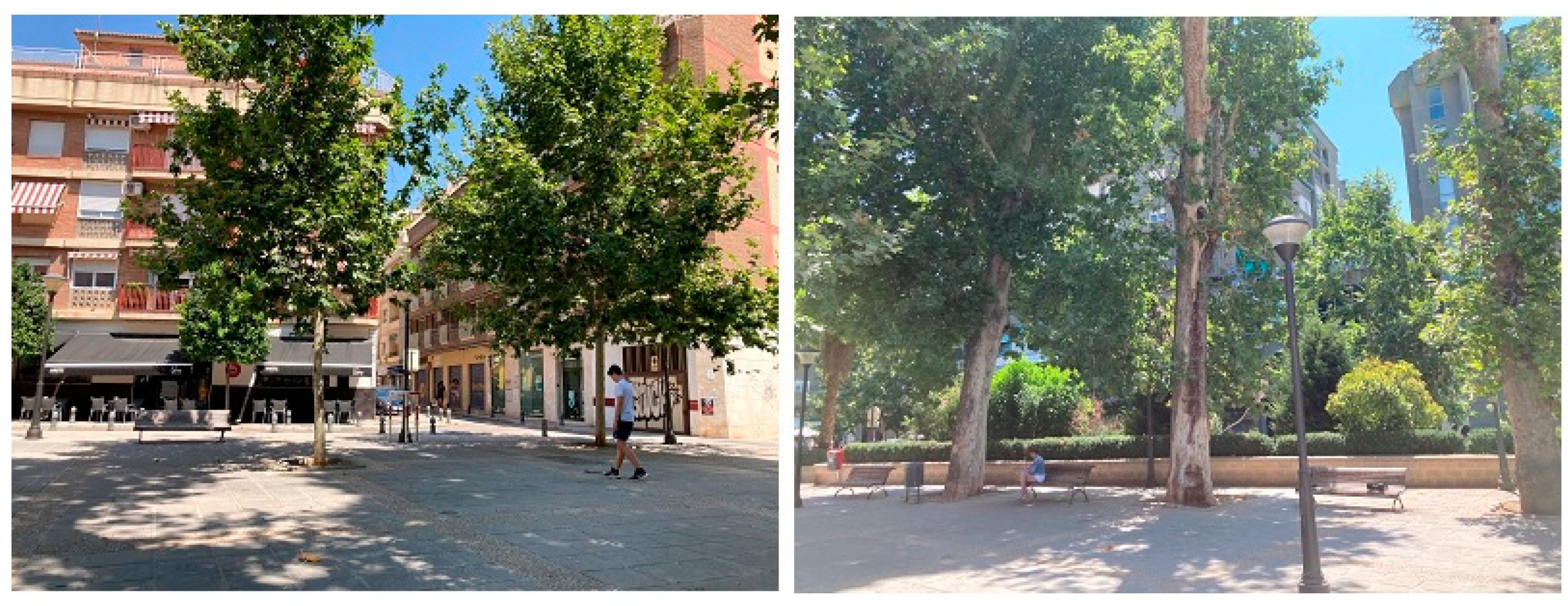

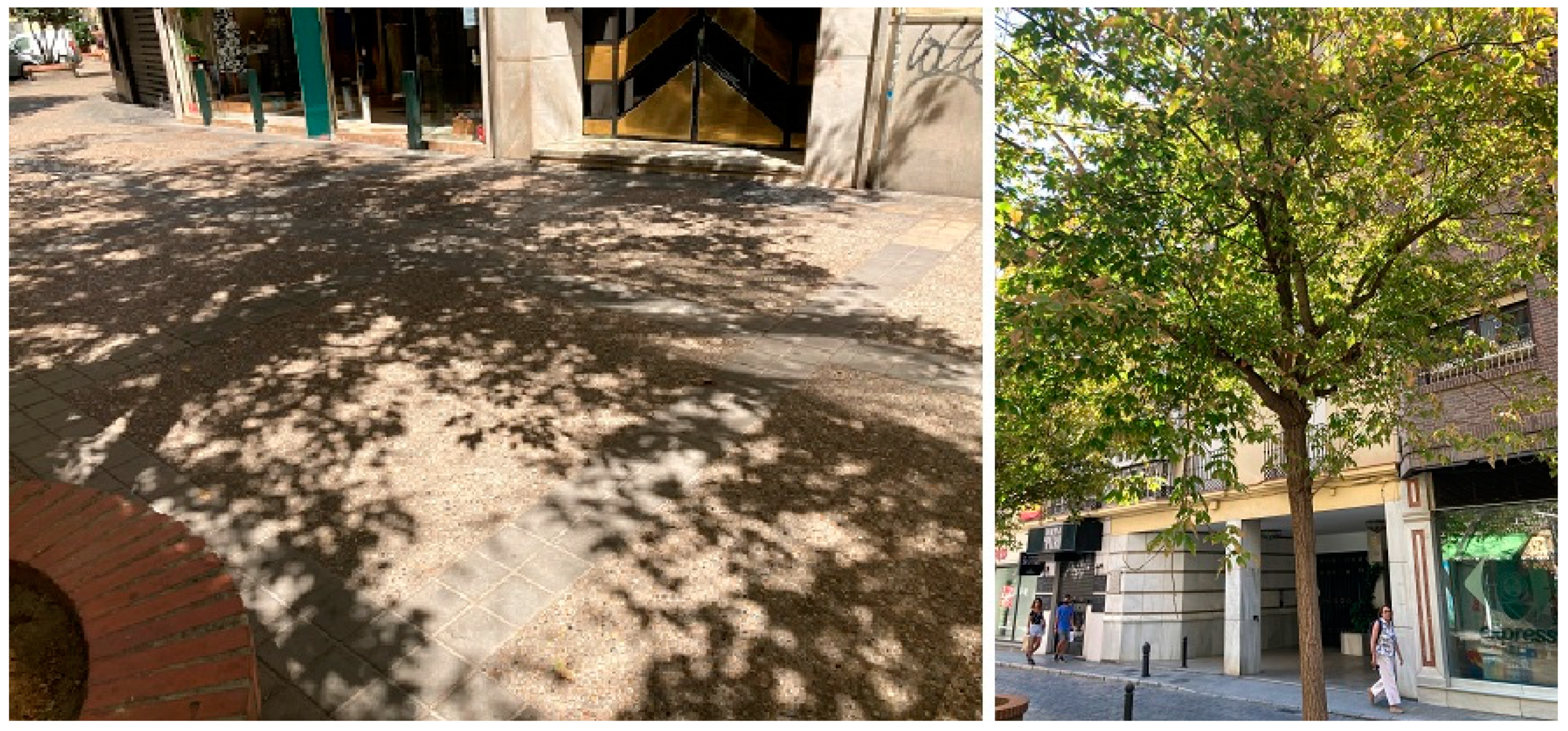
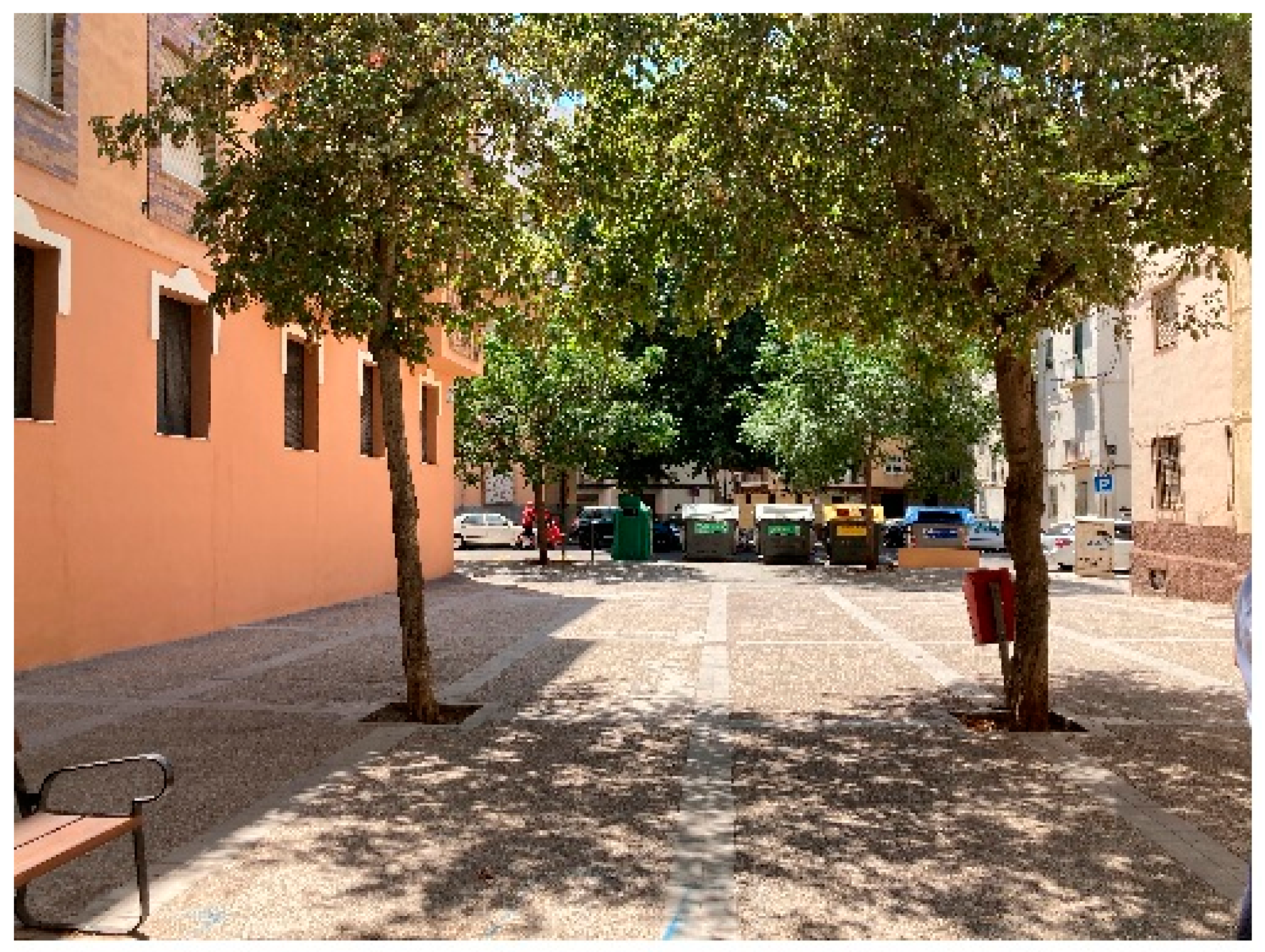
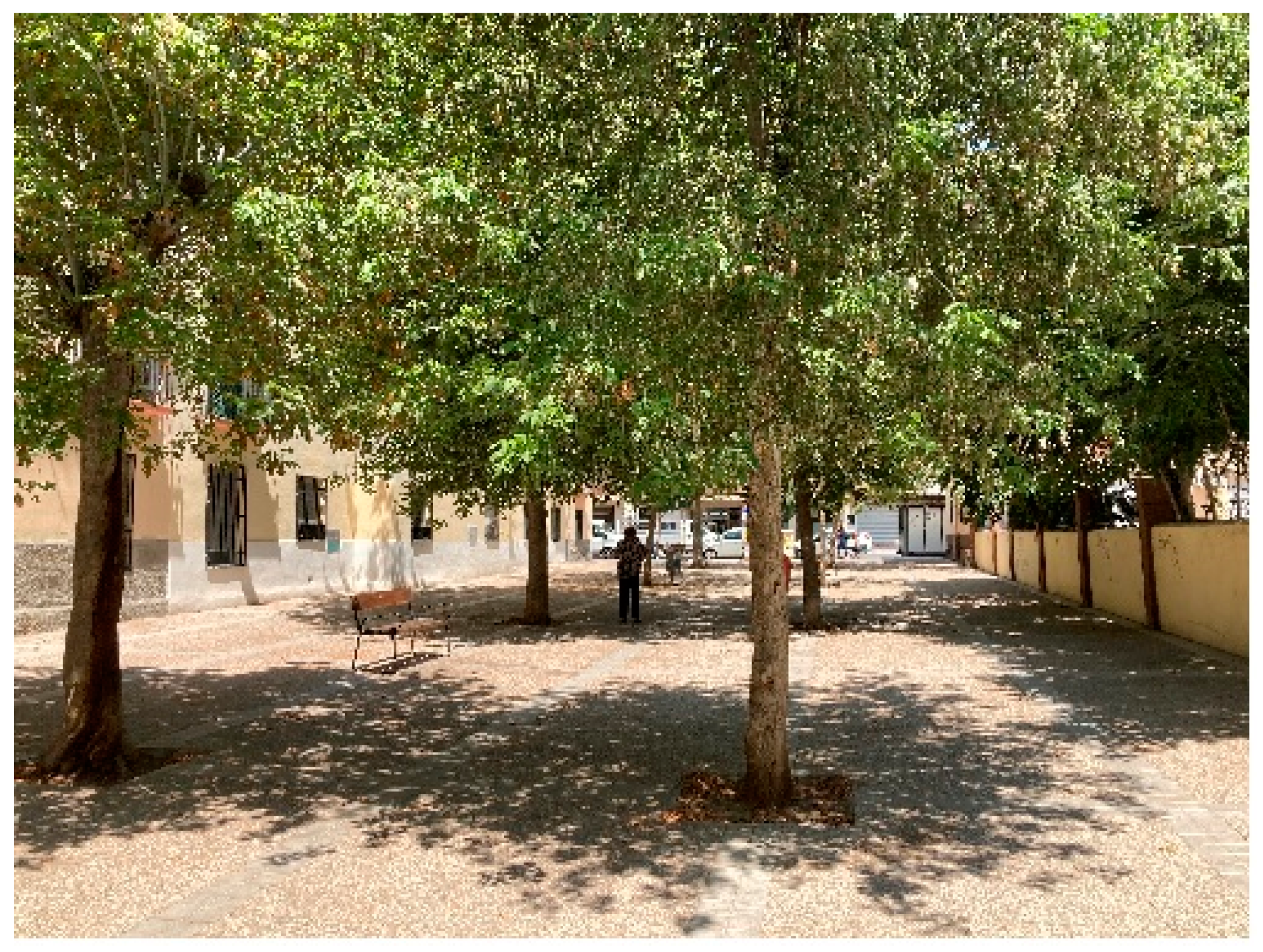
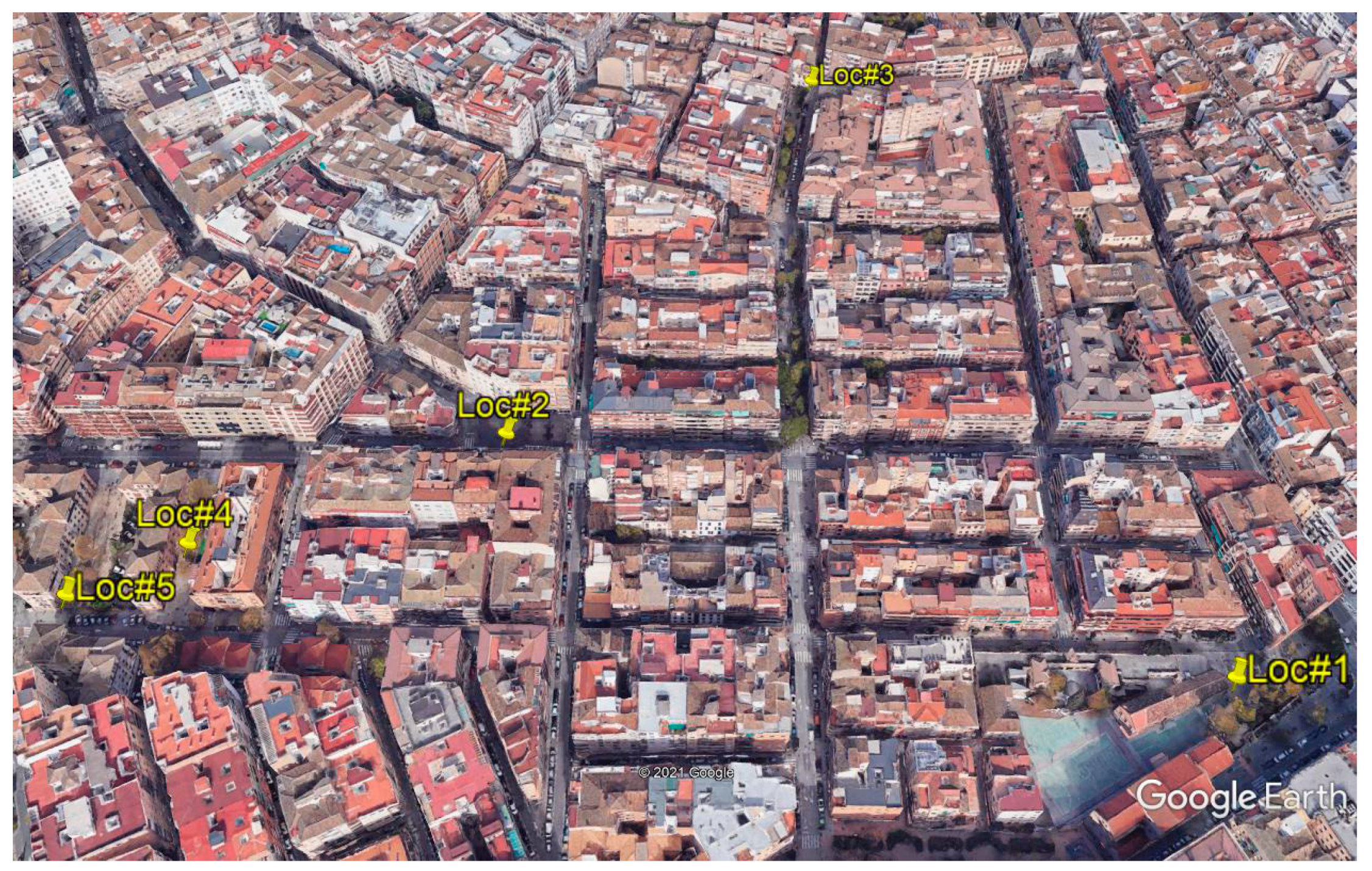
| Location | Species | Em (lux) | Um | Ev (lux) | Lhls (cd/m2) |
|---|---|---|---|---|---|
| 1 | Platanus Hispanica | 17,760 | 0.3412 | 4537 | 2249 |
| 2 | Fraxinus Ornus | 15,246 | 0.0918 | 3269 | 627 |
| 3 | Acer Negundo | 14,621 | 0.2873 | 2773 | 683 |
| 4 | Acer Negundo | 18,398 | 0.2174 | 16,555 | 1867 |
| 5 | Acer Negundo | 18,674 | 0.1607 | 14,635 | 1658 |
| Location | Species | Em Shadow (lux) | Em Sun (lux) | Attenuation (%) | Um Shadow |
|---|---|---|---|---|---|
| 1 | Platanus Hispanica | 7054 | 92,700 | 92.4 | 0.859 |
| 2 | Fraxinus Ornus | 4810 | 88,300 | 94.6 | 0.291 |
| 3 | Acer Negundo | 7239 | 66,300 | 89.1 | 0.580 |
| 4 | Acer Negundo | 7811 | 92,500 | 91.6 | 0.512 |
| 5 | Acer Negundo | 8541 | 89,600 | 90.5 | 0.351 |
Publisher’s Note: MDPI stays neutral with regard to jurisdictional claims in published maps and institutional affiliations. |
© 2021 by the authors. Licensee MDPI, Basel, Switzerland. This article is an open access article distributed under the terms and conditions of the Creative Commons Attribution (CC BY) license (https://creativecommons.org/licenses/by/4.0/).
Share and Cite
Castillo-Martínez, A.; Peña-García, A. Influence of Groves on Daylight Conditions and Visual Performance of Users of Urban Civil Infrastructures. Sustainability 2021, 13, 12732. https://doi.org/10.3390/su132212732
Castillo-Martínez A, Peña-García A. Influence of Groves on Daylight Conditions and Visual Performance of Users of Urban Civil Infrastructures. Sustainability. 2021; 13(22):12732. https://doi.org/10.3390/su132212732
Chicago/Turabian StyleCastillo-Martínez, Agustín, and Antonio Peña-García. 2021. "Influence of Groves on Daylight Conditions and Visual Performance of Users of Urban Civil Infrastructures" Sustainability 13, no. 22: 12732. https://doi.org/10.3390/su132212732
APA StyleCastillo-Martínez, A., & Peña-García, A. (2021). Influence of Groves on Daylight Conditions and Visual Performance of Users of Urban Civil Infrastructures. Sustainability, 13(22), 12732. https://doi.org/10.3390/su132212732







